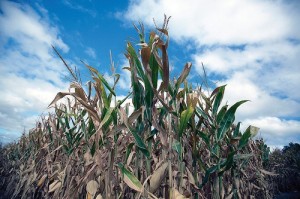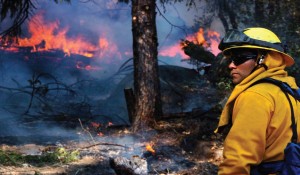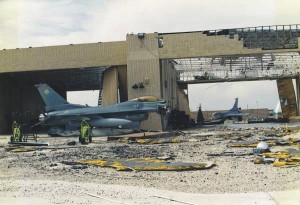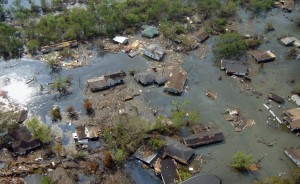 Climate change is not just a global problem, but also a threat to domestic security. A changing climate will present threats to U.S. infrastructure, agriculture, economy and population. Climate change will therefore directly affect America’s homeland and the security of its citizens.
Climate change is not just a global problem, but also a threat to domestic security. A changing climate will present threats to U.S. infrastructure, agriculture, economy and population. Climate change will therefore directly affect America’s homeland and the security of its citizens.
A New Danger at Home
2012 brought unprecedented weather to millions of Americans and personally drove home the dangerous effects of climate change. The first quarter of 2012 was the warmest on record, breaking 15,000 warm weather records. A rare “derecho” storm tore through the Mid-Atlantic area in late June, ripping down trees and utility poles.5 The storm left approximately 1.2 million homes without power and killed at least 5 people. By July 10 of this year, 61% of the country faced moderate to extreme drought conditions and a massive heat wave which devastated corn crops, put pressure on food prices and caused 74 deaths.
Regional Differences
 This year’s extreme weather events illustrate that the impacts of climate change in the U.S. are much more complicated than a simple rise in temperatures. Each region will be impacted differently; understanding these regional consequences is important to policymakers because it will allow planning for response and adaptation.
This year’s extreme weather events illustrate that the impacts of climate change in the U.S. are much more complicated than a simple rise in temperatures. Each region will be impacted differently; understanding these regional consequences is important to policymakers because it will allow planning for response and adaptation.
For a regional and state-by-state analysis of the effects of climate change on the U.S. economy, public health, security and competitiveness, please refer to the 2011 American Security Project report, “Pay Now, Pay Later”.
The Threat to Our Military
Climate change not only affects our security through its impacts on the economy and our physical infrastructure(roads, bridges, airports, etc.); it can also affect domestic and international military bases as flooding, drought and extreme weather events intensify. According to the U.S. Department of Defense (DoD) 2010 Quadrennial Defense Review, there are a number of US military installations that are already at risk.
Environmental threats to domestic U.S. military bases pose as much of a physical threat as they do an economic threat. In 1992, Hurricane Andrew nearly wiped out Homestead Air Force Base in Florida and Hurricane Katrina caused $950 million of damage to Keesler Air Force Base in Mississippi. Both of these bases were rebuilt, but it took millions of dollars to do so. Military bases in the U.S. are important for driving local economies and when they are destroyed by natural disasters, there is a ripple effect economically in the region.

damage to Homestead Air Force Base after Hurricane Andrew
Climate change poses costly threats to our domestic installations and potentially destabilizing threats to our international installations that hold strategic importance to the U.S. military. In order to prepare for these changes and to secure our military investments worldwide, the U.S. must invest in low-cost adaptation options which are effective and multidimensional.
Climate Security Issues in the Homeland
Ensuring America’s national security does not just involve protecting our borders from outside physical threats. Non-traditional threats, like climate change, are also important aspects of homeland security. Climate change poses a direct threat to U.S. national security, through its effects on critical infrastructure, the lives of citizens, the economy, and energy security.
These threats include the increased intensity of extreme weather, the destruction of critical energy and physical infrastructure, weakened economic performance, reduced agricultural yield, the outbreak of disease and negative consequences for human health.

New Orleans after Hurricane Katrina in 2005
Preparing for Climate Change
Although the headlines of the last several years show that Congress has failed to pass legislation that would mitigate climate change in an effective manner, there are many government organizations working hard to put in place plans for adapting and responding to a changing climate.
Agencies like the Environmental Protection Agency (EPA), Federal Emergency Management Agency (FEMA), National Aeronautics and Space Administration (NASA), Center for Disease Control (CDC) and the U.S. Army Corps of Engineers have been working tirelessly to address the effects climate change will have on the national water, transportation and health infrastructure across the federal and local level. However, some objectives such as creating a nation-wide response plan or educating the public on climate change remain incomplete.
On November 1, ASP hosted a launch event for the “Climate Security Report.” To read an event recap and to access audio and video of the event, click here.
American Security Project’s Climate Security Report
To learn more about the costs of Climate Change, please visit any of the links below:
Climate Security Index
National Survey On Global Warming
FACT SHEET: Arctic Climate and Energy
Offshore Oil Drilling in the Arctic
A New Discourse: Climate Change in the Face of a Shifting U.S. Energy Portfolio
America’s Energy Choices: 2012 Edition
Pay Now, Pay Later: A State-by-State Assessment of the Costs of Climate Change
Degrees of Risk: Defining a Risk Management Framework for Climate Security
Climate Change and Immigration: Warnings for America’s Southern Border
ASP and Sierra Club Release Joint Report Outlining Dangers of Our Reliance on Foreign Oil and the Need for a New Transportation Infrastructure










